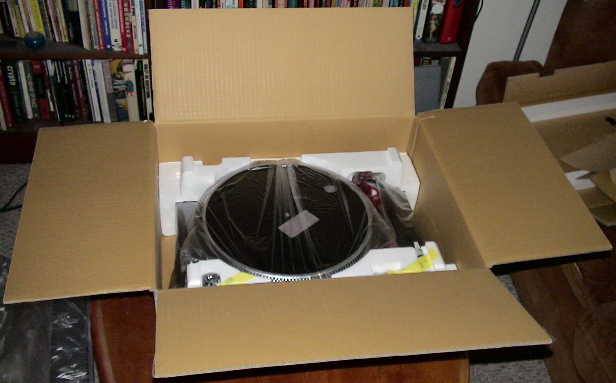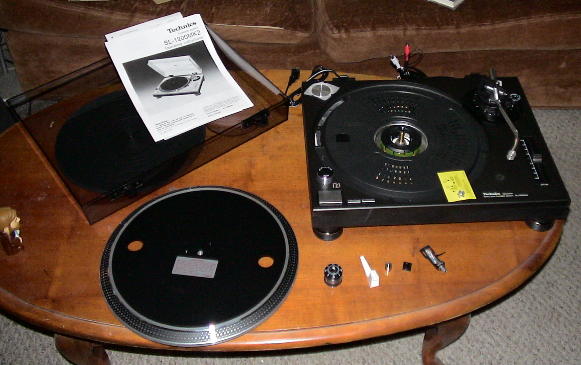The Technics SL-1200MK2

A couple of months ago I was listening to Open Arms on Journey’s Escape•, which I had just purchased on cheap vinyl, and a friend of mine asked me why it sounded so warbly. “That’s just Steve Perry,” I said, but it got me thinking; and as it happens I have another copy of Open Arms from the Heavy Metal soundtrack. Sure enough, the warble wasn’t there on the version I’d ripped several years ago from the soundtrack.
I’d noticed recently that my cheap Sony record player had been getting more finicky; certainly it’s provided decent service—I’ve owned it for eight years; and I would never have spent more than a hundred dollars on a record player when I first started listening to vinyl again. I would have just dumped all of my vinyl.
A search on-line indicated that most likely all I needed was a new belt, so I ordered one. After installing the new belt, not only did it continue to warble, but now the speed continuously increased over the course of listening to an album, such that eventually the pitch control couldn’t compensate. What now? Maybe I got the wrong belt? Maybe I need to take a look at the pitch control? How much money do I want to spend on this cheap turntable?
Maybe after listening to vinyl again for eight years, I should get a better turntable? I had a vague idea that if I wanted to find a better record player in my price range, I’d need to look for “direct drive” instead of “belt drive”, and my experience here certainly pushed me away from belts. A search of reviews on-line led me to two turntables: the Audio-Technica PL120• at about $200 and the Technics SL-1200MK2• at about $450.

The price of the Audio-Technica, the fact that it can play 78s at 78 RPM (with a special needle•), the built-in pre-amp for when I replace my current stereo, and the initial reviews inclined me towards that one at first. But a deeper search indicated that the PL120 often has a hum that won’t go away and that the pre-amp might not be that great. One thing everyone agreed on: if you like the PL120, you’ll love the SL-1200.
I ended up spending the extra money for the 1200; I don’t want to have to deal with this again. If I really need 78s, I can play them at 45 and speed them up on the computer (78s come in more than one speed so I’d probably have to do this anyway).
This is an odd purchase for me; it took a while to justify spending $450 in order to listen to a $1 Journey album. I’m a huge fan of CDs. They’re much easier to deal with: smaller, more reliable quality, and quickly ripped to iTunes. I can even listen to them in the store before I buy them to make sure they play. Vinyl I have to be very careful with, going through a specific list of checks before I can purchase even cheap vinyl—it doesn’t matter how cheap it is if it doesn’t play. Is it warped? Hold it up to the light and look down flat across the vinyl because sometimes warping isn’t obvious. Is it scratched, or is that just a smudge? Does the record match the package? (Yes, I’ve been bitten by this—after carefully looking over the vinyl to make sure it wasn’t scratched or warped, I didn’t notice until I got home that it wasn’t actually Al Hirt at all.)

Putting it together was easy, but there are several small parts, so read the instructions.
Even after going through the 7-point checklist, general wear and tear sometimes means that a record I thought would be playable turns out not to be. So why do I still buy vinyl? Because every once in a while I go into a second-hand store and I come out with some crazy, never-before-seen-by-man album like “College Fraternity Songs”, or an album that’s no longer available such as William Eaton’s Struggle Buggy, or an album that speaks to my seventies/eighties coming-of-age years but that I’m not willing to spend ten bucks on. Or something that just plain has a great album package, like Alice Cooper’s From the Inside• or Southern Culture on the Skids’ Double Wide and Live•.
There are three kinds of vinyl I’ll buy:
- Albums that I can’t get on CD (except maybe at extremely high import prices);
- Albums that I don’t want to pay for on CD (most of the stuff that was on the radio from 1978-1984);
- Albums that take advantage of the packaging format of vinyl.
This ends up meaning that I have several hundred albums on vinyl.
Back to the SL-1200. Installation was fairly easy, marred momentarily because I had temporarily forgotten the difference between needle and cartridge•. I knew that the SL-1200 didn’t come with a cartridge. Since it had been over a year since replacing the needle on my Sony I had forgotten that cartridge meant more than just the box that the needle hangs from. Not willing to wait for another Amazon shipment I ended up pulling the cartridge from the Sony and installing it on the 1200. Fortunately they’re all standard. (Actually, because I didn’t want to pull the cheap cartridge off of the Sony, I installed the entire headshell on the 1200, saving the 1200 headshell for when I get a better cartridge.)

Because the best way to test a $450 turntable is with a classic $1 album from the seventies.
Be very careful with the smallest plastic package, the one that contains the screws for attaching the cartridge to the headshell. It’s in a tiny, tightly-wrapped plastic bag and it contains tiny, almost invisibly-clear plastic washers. It would be very easy to lose one of the washers while forcing the plastic bag to unwrap.
Pay close attention to the photos in the setup instructions. They make sense, even if they don’t appear to at first.
The moment of truth: I’ve set up the turntable and have it turned on with Escape going round and round. There are three dots moving along in different directions, and I’m very familiar with using them for speed adjustment from the Sony. But which set of dots is supposed to be stationary? You SL-1200 veterans are probably sniggering right now; in my glee at putting a record on my new turntable, I forgot why I bought this turntable. In fact, the fourth line of dots was the important one—the one that I didn’t notice because it was already perfectly still out of the box. Pitch control on the 1200 is for pitch control, not “make the damn thing work already”.
It passes the Escape test with flying colors; Steve Perry warbles like he’s supposed to, without any additional assistance from the turntable. I threw quite a few old albums at it the next day without a single problem, including some that the older player couldn’t play without skipping. I’m very satisfied with this turntable.
- Technics SL-1200MK2 Turntable•
- Probably the best turntable in its price range. If you’re looking to get a reliable, durable turntable for playing vinyl, this is the turntable to get.
- Technics SL-1200 Black Turntable•
- This is the SL-1200MK2, but in black instead of silver; otherwise it’s the same turntable.
- Shure M97xE High-Performance Magnetic Phono Cartridge•
- “M97xE phono cartridge, headshell screwdriver, stylus cleaning brush, mounting hardware, stylus guard, user’s manual.”
- Audio-Technica AT-PL120 Professional Direct-Drive Turntable•
- This might be a great deal, or it might not; read the customer reviews and search on-line. Some people love it; others can’t get over a pervasive hum underneath the music.
- Shure M78S Wide Groove Monophonic Cartridge•
- 78’s require a different needle than LPs and 45s, or you risk damaging the record.
- Escape•
- This album contains a handful of classic late seventies rock tunes. If you were in high school in 1978, you’ll instantly recognize them. From the opening track (Don’t Stop Believing) to the closing track (Open Arms), passing through the classic Stone in Love, this album probably defines my love-hate relationship with vinyl.
- Double Wide and Live•
- Possibly Southern Culture on the Skids’ best live album, there are great live versions of some of their best but not already over-played songs: Doublewide, Licquored Up and Lacquered Down, Banana Pudding, and more.
- From the Inside•
- One of Alice Cooper’s better concept albums, this collaboration with Bernie Taupin was probably influenced by One Flew Over the Cuckoo’s Nest.
More stereo equipment
- Miracle and Wonder: The Pioneer 3200/3300BT
- “These are the days of miracle and wonder. This is a long-distance call.” I’ve been using the Pioneer 3200BT bluetooth-enabled stereo in my car for a year now. It really is amazing what we can do nowadays.
- M-Audio FireWire Audiophile
- M-Audio’s FireWire Audiophile is a neat little device that adds high quality audio in and out via FireWire.
